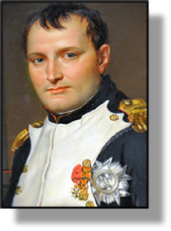 xxxxxAs we have seen, it was in 1799 (G3b) that Napoleon, having returned from his Egyptian campaign, was elected First Consul. In this office he carried out a vast programme of reform at home, making widespread improvements in government administration, the country’s financial affairs, and the judicial system - the so-called Napoleonic Code. Meanwhile, on the battlefield, he won a resounding victory over the Austrians at the Battle of Marengo in 1800 and, bringing all his opponents to the peace table, gained favourable terms at the Treaty of Amiens in 1802. In that year, as a “token of national gratitude”, he was made Consul for life by a huge majority in a public vote - over three and a half million against a mere 8,374! (The portrait is by the French artist Jacques-Louis David.)
xxxxxAs we have seen, it was in 1799 (G3b) that Napoleon, having returned from his Egyptian campaign, was elected First Consul. In this office he carried out a vast programme of reform at home, making widespread improvements in government administration, the country’s financial affairs, and the judicial system - the so-called Napoleonic Code. Meanwhile, on the battlefield, he won a resounding victory over the Austrians at the Battle of Marengo in 1800 and, bringing all his opponents to the peace table, gained favourable terms at the Treaty of Amiens in 1802. In that year, as a “token of national gratitude”, he was made Consul for life by a huge majority in a public vote - over three and a half million against a mere 8,374! (The portrait is by the French artist Jacques-Louis David.)
xxxxxAt the beginning of 1804, however, an event occurred which, though intended to end Napoleon’s days as Consul and, indeed, the days of Napoleon himself, served only to bring him greater honour and prestige. In February of that year a serious plot to assassinate him, financed by the British, was unmasked, and the two leading conspirators were duly arrested. Georges Cadoudal, a known rebel, was executed, and the other one, the former General Charles Pichegru, died in prison. However, this attempt re-awakened royalist hostility, and to counter this threat the Senate petitioned Napoleon to establish his own dynasty. To this proposal he raised no objection! And whilst the very thought of it alarmed the leaders of Europe and offended liberal opinion, the French people cast an overwhelming vote in support of the idea (something like a thousand to one in favour!). As for Napoleon, he saw himself as the successor not of Louis XVI - heaven forbid! - but of the conqueror Charlemagne, crowned Emperor of the Franks back in 800. He was determined to use his royal dynasty, based on the will of the people, to ensure the permanency of the ideals of the Revolution he had fought so hard to 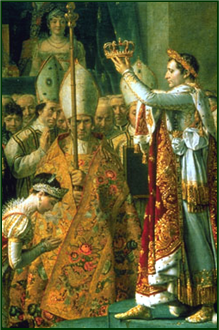 defend and spread.
defend and spread.
xxxxxThe coronation - a magnificent affair - took place at Notre Dame Cathedral, Paris, in December 1804. Pope Pius VII was invited to attend, but his contribution was confined to little more than anointing the couple with oil and giving them his blessing. Napoleon,xdetermined to be beholden to no one - least of all the Church -, picked up the crowns from the high altar and crowned first himself and then his wife Josephine as Emperor and Empress of the French (illustrated by a detail from a work by the French painter Jacques-Louis David). Then, less than a year later, he visited Milan and crowned himself King of Italy with the iron crown of the old kings of Lombardy. In the meantime he set up a royal court and appointed “Grand Dignitaries” such as Arch-Chancellors of the Empire and Imperial Marshals. Furthermore, in order to keep power in his own hands, over the next four years he set about placing members of his close family on the thrones of four of his satellite states - Naples, Holland, Westphalia and Spain - and he married a number of his relatives into distinguished European families. Indeed, in 1810 he himself divorced Josephine and married Marie Louise, daughter of the Austrian Emperor Francis II, in the hope of obtaining a male heir from proven stock.
xxxxxMeanwhile, on the battlefront the Treaty of Amiens had run its course by 1803, and the war with Great Britain had resumed. Planning to invade southern England, Napoleon assembled a large army - some 170,000 men - at Boulogne, and about 2000 ships along the Channel coast. However, he was forced to abandon this idea when the British formed the Third Coalition against France, and he found himself at war with Austria and Russia. Taking command, therefore, of his erstwhile invasion force - the nucleus of his Grande Armée - he marched through Germany with his customary speed and, entering Austria, completely outmanoeuvred his enemy. He defeated the Austrians at the Battle of Ulm, in October 1805, and then, after occupying Vienna, crushed a combined Austro-Russian force at the Battle of Austerlitz, one of his greatest victories. In the meantime, however, a Franco-Spanish fleet was defeated by the British at the Battle of Trafalgar, and this confirmed Britain’s mastery of the sea. It put an end to any hope of invading England in the near future, and it strengthened Britain’s position in the trade war that Napoleon was about to launch.
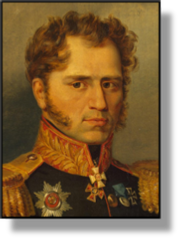 xxxxxFollowing his victory at Austerlitz, the Austrians were forced to sign the Treaty of Pressburg. Napoleon gained Venice and Dalmatia to add to his Italian kingdom, and he set up the Confederation of the Rhine, a group of German states in central Europe which replaced the Holy Roman Empire and came directly under French protection. This move was regarded as a serious threat by the states of Eastern Europe. Yet another coalition was created against France, but Prussia, under its leader Frederick William II, chose to take on the French before its ally, Russia, was ready to assist. The result was a humiliating defeat for the Prussians at the Battles of Jena and Auerstadt in 1806. And when the Russians took to the field they too were overwhelmed, first at the Battle of Eylau in February 1807, and then at the Battle of Friedland in the June. The Treaty of Tilsit that followed brought about the Kingdom of Westphalia and the Grand Duchy of Warsaw, reducing Prussia to a second-rate power. On the other hand, the Russian leader, the wily Alexander I (illustrated), offered to do a U-turn and come out in support of the French. He and Napoleon met on a barge on the river Niemen, and the deal was struck. At this juncture, Napoleon’s prime aim was to bring Britain to heel in order to prevent its government from constantly organising and subsidising continental coalitions against him.
xxxxxFollowing his victory at Austerlitz, the Austrians were forced to sign the Treaty of Pressburg. Napoleon gained Venice and Dalmatia to add to his Italian kingdom, and he set up the Confederation of the Rhine, a group of German states in central Europe which replaced the Holy Roman Empire and came directly under French protection. This move was regarded as a serious threat by the states of Eastern Europe. Yet another coalition was created against France, but Prussia, under its leader Frederick William II, chose to take on the French before its ally, Russia, was ready to assist. The result was a humiliating defeat for the Prussians at the Battles of Jena and Auerstadt in 1806. And when the Russians took to the field they too were overwhelmed, first at the Battle of Eylau in February 1807, and then at the Battle of Friedland in the June. The Treaty of Tilsit that followed brought about the Kingdom of Westphalia and the Grand Duchy of Warsaw, reducing Prussia to a second-rate power. On the other hand, the Russian leader, the wily Alexander I (illustrated), offered to do a U-turn and come out in support of the French. He and Napoleon met on a barge on the river Niemen, and the deal was struck. At this juncture, Napoleon’s prime aim was to bring Britain to heel in order to prevent its government from constantly organising and subsidising continental coalitions against him.
xxxxxHaving failed in his bid to invade England in 1805, Napoleon saw a blockade of British trade as the best means to achieve his end. In 1806 he imposed the Continental System, closing all continental ports to British shipping in order to bring Britain to its economic knees and, ipso facto, the peace table. It was a policy that, in the long term, proved his downfall. The British, masters of the seas, were able to divert much of their trade to colonial possessions, but the countries on the continent, also seriously affected by the trade blockade, had no such alternative. For them the banning of trade with Britain resulted in much greater hardship to their industries and the people who depended upon them.
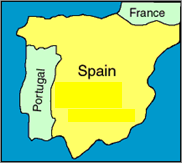 xxxxxThe first to break rank was Portugal, for long an important trading nation with Britain. In 1808 Napoleon was obliged to invade the country to enforce the blockade, and this inevitably involved him in Spanish affairs. To gain control of this region, in June of that year he installed his brother Joseph as King of Spain and, as a result both countries (Portugal and Spain) rose up in revolt. At one time Napoleon himself was obliged to take an army to Madrid to put down a rebellion. In August a British expeditionary force arrived in Portugal to add their support. The war that followed - the Peninsular War - proved a constant drain on French resources over the next five years, and eventually led to defeat of the French and their withdrawal from Spain.
xxxxxThe first to break rank was Portugal, for long an important trading nation with Britain. In 1808 Napoleon was obliged to invade the country to enforce the blockade, and this inevitably involved him in Spanish affairs. To gain control of this region, in June of that year he installed his brother Joseph as King of Spain and, as a result both countries (Portugal and Spain) rose up in revolt. At one time Napoleon himself was obliged to take an army to Madrid to put down a rebellion. In August a British expeditionary force arrived in Portugal to add their support. The war that followed - the Peninsular War - proved a constant drain on French resources over the next five years, and eventually led to defeat of the French and their withdrawal from Spain.
xxxxxEncouraged by this revolt against French rule, Austria returned to the fight but, despite some early success was decisively defeated by Napoleon at the Battle of Wagram in 1809. Even more land was lost to the French, but Austria gained some prestige by Napoleon’s marriage to Marie Louise, daughter of the Austrian Emperor Francis I in 1810. As we have seen, anxious for an heir to his throne, Napoleon had been granted a divorce from Josephine in December 1809, and his new bride provided him with a son - the King of Rome - within twelve months. By that time he had annexed the Papal States, taken the pope prisoner, seized Holland, and established control over Hanover, Hamburg and Lubeck. Despite the uphill struggle in the Peninsular War, Napoleon appeared to be at the height of his power, striding the continent like a colossus. Austria, Prussia and Russia had been defeated in battle, 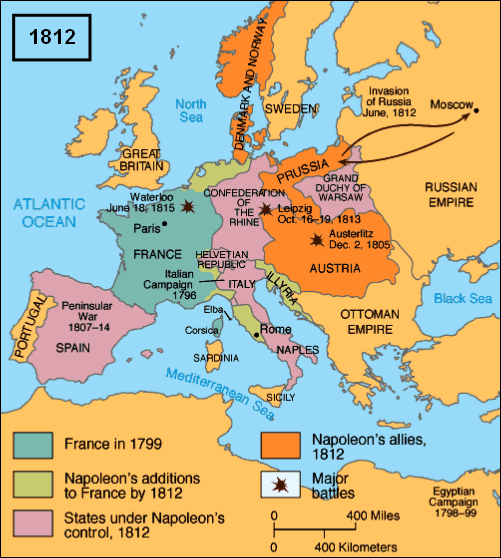 and he and his relatives and cohorts ruled over France, Italy, Switzerland, Holland, much of Germany, Spain, Naples and the Grand Duchy of Warsaw.
and he and his relatives and cohorts ruled over France, Italy, Switzerland, Holland, much of Germany, Spain, Naples and the Grand Duchy of Warsaw.
xxxxxHis fall from that height began in earnest in 1812 with his decision to invade Russia, taken - as in the case of Portugal - because of that country’s failure to comply with the Continental System. Up to that time he had fought the Russians in East Prussia and Moravia (the present-day Czech Republic). Now he contemplated a march deep into Russia itself to capture Moscow and force Alexander I to surrender. This proved a colossal military blunder. His massive army, some 500,000 strong, suffered sufficient hardship on the outward journey. The Russians adopted a scorched-earth policy and left little or no food for so large an invasion force. And by the time that Napoleon had won the Battle of Borodino - the only engagement of any significance - and entered the capital, the Russian winter had well and truly set in. With no sign of surrender on the part of the Tsar, Napoleon was forced to order the retreat from Moscow. Constantly attacked by Russian forces, lacking food, and travelling in close-on arctic conditions, only about 40,000 of Napoleon’s Grand Army survived this debacle.
xxxxxTo add to his misery - as we shall see in 1812 - on crossing the Berezina River, Napoleon heard of an abortive coup in Paris, engineered by Claude François de Malet. In October this former general had attempted to seize power by declaring that the Emperor had died in Russia. His plot was unmasked, and he was executed, but the political unrest had continued. Leaving what was left of his army, Napoleon hurried back to Paris. Here he re-imposed his authority and, ever optimistic, raised more money and began recruiting a new, conscript army. The allies, now sensing that France was on its last legs, formed yet another alliance - the sixth. Made up of Prussia, Russia, Britain and Sweden, it took to the battlefield once again in the spring of 1813. It got a shock. In May it was defeated at the battles of Lutzen and Bautzen, and even after Austria joined the coalition, Napoleon gained a further victory at Dresden towards the end of August. However, less than two months later, Napoleon, outnumbered two to one, was clearly defeated at the Battle of Leipzig - or, as it came to be called, the Battle of the Nations - in October 1813. As we shall see, Napoleon refused to surrender and held out for some time, but it seemed that at long last the sun had begun to set on Napoleon’s European Empire.
xxxxxIncidentally, the plan to assassinate Napoleon in 1804 was not the first attempt on his life. On Christmas Eve, 1800, whilst on his way to see an opera, a barrel of explosives, hidden in a small wagon, was blown up as the First Consul’s carriage travelled along the Rue Saint Nicaise. Luckily for him, the explosion came too late to harm the carriage, but 22 people were killed, and over 40 houses were damaged. ……
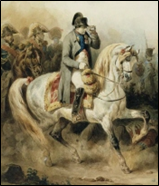 xxxxx…… Napoleon’s favourite horse Le Vizir, a thoroughbred white Arab, was presented to him by the Sultan of Turkey in 1805. Like all his horses, it was branded with the imperial crown and the initial ‘N’. Le Vizir accompanied his master into exile on St. Helena and outlived him. On his death he was preserved, and he now stands in the museum of Les Invalides, near to his master’s tomb. ……
xxxxx…… Napoleon’s favourite horse Le Vizir, a thoroughbred white Arab, was presented to him by the Sultan of Turkey in 1805. Like all his horses, it was branded with the imperial crown and the initial ‘N’. Le Vizir accompanied his master into exile on St. Helena and outlived him. On his death he was preserved, and he now stands in the museum of Les Invalides, near to his master’s tomb. ……
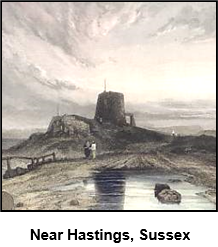
xxxxx…… Facedxwith the threat of a French invasion in 1804, the British built a large number of “Martello Towers” along their Channel coast, some of them situated just out to sea. Round in shape, solidly built, and provided with a flat roof for a gun emplacement, they were named after and modelled on a tower at Cape Mortella in Corsica which the British had experienced great difficulty in capturing in 1794. Over one hundred were built between 1805 and 1812, spaced about 600 yards apart, but they never fired a shot in anger!



 xxxxxAs we have seen, it was in 1799 (G3b) that Napoleon, having returned from his Egyptian campaign, was elected First Consul. In this office he carried out a vast programme of reform at home, making widespread improvements in government administration, the country’s financial affairs, and the judicial system -
xxxxxAs we have seen, it was in 1799 (G3b) that Napoleon, having returned from his Egyptian campaign, was elected First Consul. In this office he carried out a vast programme of reform at home, making widespread improvements in government administration, the country’s financial affairs, and the judicial system - defend and spread.
defend and spread.  xxxxxFollowing his victory at Austerlitz, the Austrians were forced to sign the Treaty of Pressburg. Napoleon gained Venice and Dalmatia to add to his Italian kingdom, and he set up the Confederation of the Rhine, a group of German states in central Europe which replaced the Holy Roman Empire and came directly under French protection. This move was regarded as a serious threat by the states of Eastern Europe. Yet another coalition was created against France, but Prussia, under its leader Frederick William II, chose to take on the French before its ally, Russia, was ready to assist. The result was a humiliating defeat for the Prussians at the Battles of Jena and Auerstadt in 1806. And when the Russians took to the field they too were overwhelmed, first at the Battle of Eylau in February 1807, and then at the Battle of Friedland in the June. The Treaty of Tilsit that followed brought about the Kingdom of Westphalia and the Grand Duchy of Warsaw, reducing Prussia to a second-
xxxxxFollowing his victory at Austerlitz, the Austrians were forced to sign the Treaty of Pressburg. Napoleon gained Venice and Dalmatia to add to his Italian kingdom, and he set up the Confederation of the Rhine, a group of German states in central Europe which replaced the Holy Roman Empire and came directly under French protection. This move was regarded as a serious threat by the states of Eastern Europe. Yet another coalition was created against France, but Prussia, under its leader Frederick William II, chose to take on the French before its ally, Russia, was ready to assist. The result was a humiliating defeat for the Prussians at the Battles of Jena and Auerstadt in 1806. And when the Russians took to the field they too were overwhelmed, first at the Battle of Eylau in February 1807, and then at the Battle of Friedland in the June. The Treaty of Tilsit that followed brought about the Kingdom of Westphalia and the Grand Duchy of Warsaw, reducing Prussia to a second- xxxxxThe first to break rank was Portugal, for long an important trading nation with Britain. In 1808 Napoleon was obliged to invade the country to enforce the blockade, and this inevitably involved him in Spanish affairs. To gain control of this region, in June of that year he installed his brother Joseph as King of Spain and, as a result both countries (Portugal and Spain) rose up in revolt. At one time Napoleon himself was obliged to take an army to Madrid to put down a rebellion. In August a British expeditionary force arrived in Portugal to add their support. The war that followed -
xxxxxThe first to break rank was Portugal, for long an important trading nation with Britain. In 1808 Napoleon was obliged to invade the country to enforce the blockade, and this inevitably involved him in Spanish affairs. To gain control of this region, in June of that year he installed his brother Joseph as King of Spain and, as a result both countries (Portugal and Spain) rose up in revolt. At one time Napoleon himself was obliged to take an army to Madrid to put down a rebellion. In August a British expeditionary force arrived in Portugal to add their support. The war that followed - and he and his relatives and cohorts ruled over France, Italy, Switzerland, Holland, much of Germany, Spain, Naples and the Grand Duchy of Warsaw.
and he and his relatives and cohorts ruled over France, Italy, Switzerland, Holland, much of Germany, Spain, Naples and the Grand Duchy of Warsaw.  xxxxx…… Napoleon’s favourite horse Le Vizir, a thoroughbred white Arab, was presented to him by the Sultan of Turkey in 1805. Like all his horses, it was branded with the imperial crown and the initial ‘N’. Le Vizir accompanied his master into exile on St. Helena and outlived him. On his death he was preserved, and he now stands in the museum of Les Invalides, near to his master’s tomb. ……
xxxxx…… Napoleon’s favourite horse Le Vizir, a thoroughbred white Arab, was presented to him by the Sultan of Turkey in 1805. Like all his horses, it was branded with the imperial crown and the initial ‘N’. Le Vizir accompanied his master into exile on St. Helena and outlived him. On his death he was preserved, and he now stands in the museum of Les Invalides, near to his master’s tomb. ……


